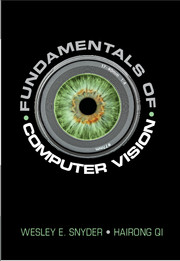Book contents
- Frontmatter
- Dedication
- Contents
- Preface
- For the Instructor
- Part I Preliminaries
- Part II Preprocessing
- Part III Image Understanding
- Part IV The 2D Image in a 3D World
- 12 Relating to Three Dimensions
- 13 Developing Computer Vision Algorithms
- A Support Vector Machines
- B How to Differentiate a Function Containing a Kernel Operator
- C The Image File System (IFS) Software
- Author Index
- Subject Index
- References
12 - Relating to Three Dimensions
from Part IV - The 2D Image in a 3D World
Published online by Cambridge University Press: 25 October 2017
- Frontmatter
- Dedication
- Contents
- Preface
- For the Instructor
- Part I Preliminaries
- Part II Preprocessing
- Part III Image Understanding
- Part IV The 2D Image in a 3D World
- 12 Relating to Three Dimensions
- 13 Developing Computer Vision Algorithms
- A Support Vector Machines
- B How to Differentiate a Function Containing a Kernel Operator
- C The Image File System (IFS) Software
- Author Index
- Subject Index
- References
Summary
I've always been passionate about geometry and the study of three-dimensional forms.
– Erno RubikIntroduction
Most of the images we see are projections of surfaces in the three-dimensional world around us. They result from light reflected off surfaces in that 3D world, passing through the lens of a camera, and intersecting the focal plane of the camera. These images that result from light reflected in this way are called “luminance” or “brightness” images in this book.
What was not described earlier in this book is the relationship between the 3D world and 2D images, including matching of one to another. We begin by reviewing the geometry of a simple projective camera and relating it to position of points in three dimensions. What we would really like is a range image from every scene, but that isn't always feasible, so we look at several aspects of the 2D–3D relationship:
• (Section 12.2) It is necessary to determine the 3D position of a point in space that is seen by two cameras, assuming the two cameras are known. This is the problem commonly known as stereopsis. When we say a camera is “known” we mean we know where it is, which way it is pointing, and all its internal parameters like focal length, resolution, and others.
• (Section 12.3) Actually it is not really necessary to know all about the cameras. Almost all the relevant information about both cameras can be determined if there are several points in each camera view that can be put into correspondence. An adequate solution to this problem leads to a wonderful little matrix called the fundamental matrix that contains all we need to know for the two-camera problem. Underlying this work is the correspondence problem, the problem of identifying which point in one image corresponds to which point in the other image. Finding a robust solution to the correspondence problem may be difficult.
• (Section 12.4) Once we have an approach to the correspondence problem, we can do partial matching of images and image stitching.
• (Section 12.5) If, instead of two cameras, we have one camera and a controllable light source, we can still find the 3D location of points in space. We address controllable lighting and how to achieve range imaging in this context.
- Type
- Chapter
- Information
- Fundamentals of Computer Vision , pp. 303 - 349Publisher: Cambridge University PressPrint publication year: 2017



